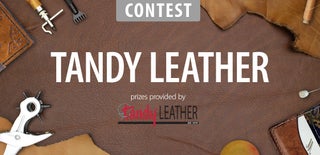Introduction: Leather Underbust Harness
When I discovered Tandy Leather a few years ago, my life was forever changed. Okay, maybe that sounds a little dramatic, but I really do love Tandy. The staff were extremely helpful and the environment was so cool! I honestly don't remember if I planned on buying anything that first visit, but I walked out with a big piece of leather and an idea. I had to go back again for more materials (not that I minded, that place is awesome), but all my materials came from Tandy.
I looked around on the Internet for awhile, trying to figure out how to begin, but I eventually ended up guessing a lot and making my own design. Here's how that went:
Step 1: The Design
As with almost every project I take on, I started in Adobe Illustrator. I measured myself a lot and tweaked the design until it was exactly what I wanted.
Step 2: Patterning and Tracing
I cut out my design on parchment paper. For the straps, I used a ruler since they're just long rectangles.
Step 3: Cut It Out
I used a carpet knife to carefully cut everything out along the lines. *Pro Tip! Don't stab yourself in the leg with carpet knives.
Step 4: I Punched Lots of Holes in Them
Using a ruler, I marked where every hole needed to be. Then I used a leather hole punching set to punch all the holes. It took awhile and I hit myself with the hammer seven times.
The holes for the rivets ended up being too small, so I broke out the drill and made them bigger.
Step 5: Cowdust
I tested out all my pieces with the hardware, and it turns out the leather I got was too thick when it came to the straps. So I got out the belt sander and sanded them down until they worked. In the future, I will try using a planer instead.
Note: I very recently learned that you should NOT wear gloves while using a belt sander. For more info, see the comments section of this Instructable.
Step 6: Leather Dyeing
I used the cheap kind of dye that includes a topcoat because it costs less and takes less time. The bigger pieces were more difficult because it dried so fast I couldn't make it even. But it turned out pretty well and the uneven-ness gives it a good look for steampunk.
Step 7: So Riveting
Riveting was not as easy as I had hoped. I messed a few up, and there's not really a good way to fix it. But it ended up mostly fine. And it all held together, which is the most important part.
Step 8: Wear It!
It fits! The holes on all the straps make it adjustable, but some of the holes are just for show. It can't actually be adjusted smaller than this. I'm not sure how well it would work adjusted too much larger either, but it was designed to fit to me, so it doesn't really matter. If you're making your own, make sure you get your measurements down right.
I've worn this several times, for different cosplay type things. I've used it for steampunk and for pirate outfits and for the renaissance festival.
I hope you enjoyed my Instructable and I hope you like my harness! Thanks for reading!

Third Prize in the
Tandy Leather Contest 2016











